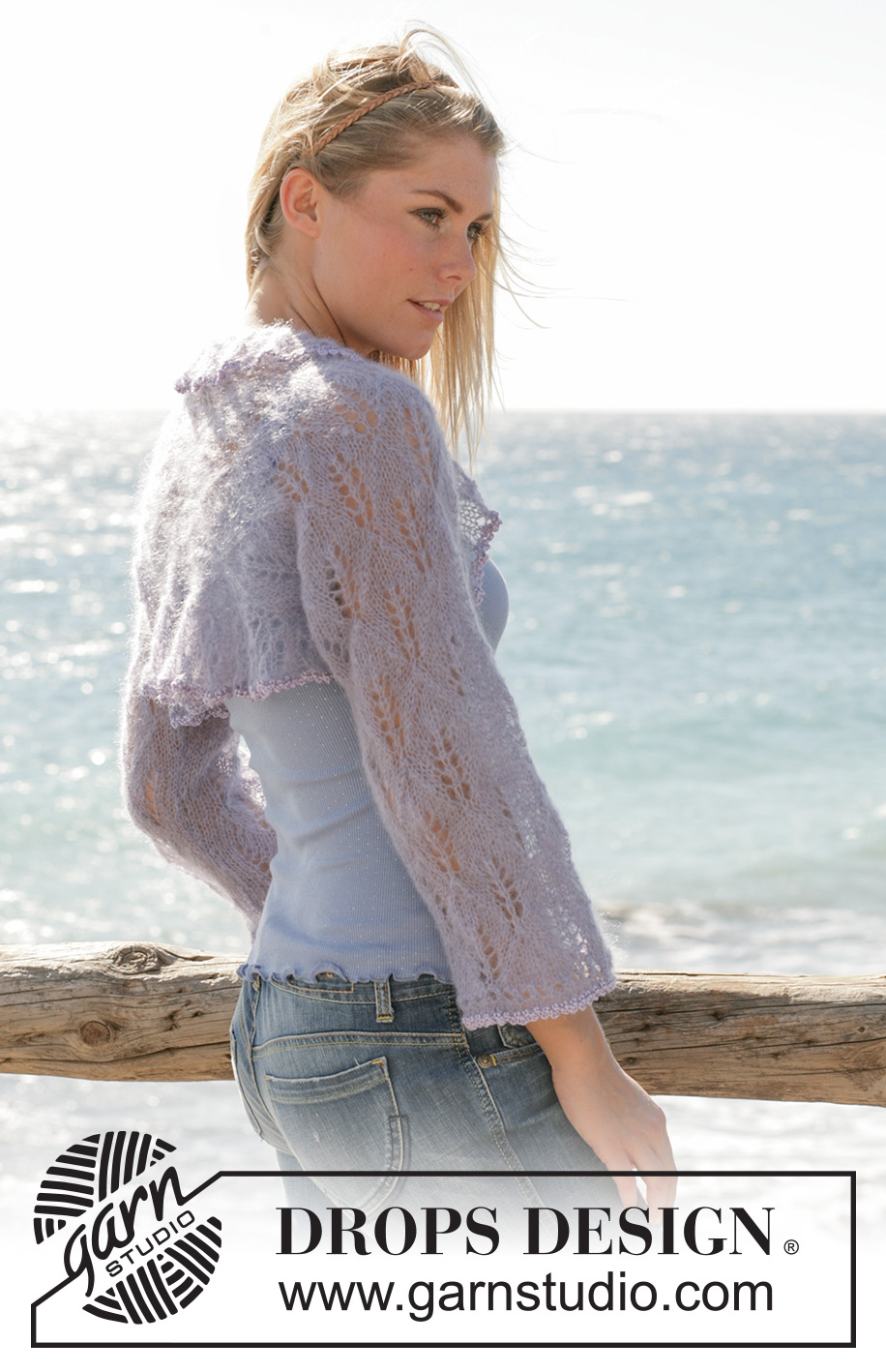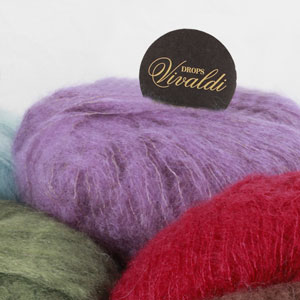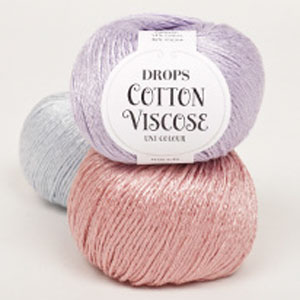Comments / Questions (19)
![]() Laila Hageberget Høgås wrote:
Laila Hageberget Høgås wrote:
Jeg skal strikke Loves embrace og lurer på hvordan jeg strikker M 1
17.01.2025 - 13:12DROPS Design answered:
Hej Laila, 5.pind i M.1 strikkes således 2ret sammen, 1 omslag, 2ret sammen, 1 omslag hele pinden ud :)
17.01.2025 - 13:25
![]() Anne Aakre wrote:
Anne Aakre wrote:
Hei Jeg skal strikke boleroen Loves enbrace størrelse smal med garnet drops KID slik. Hvor mye garn må jeg kjøpe?
20.05.2022 - 14:14DROPS Design answered:
Hei Anne. Om du bruker vår garnkalkulator vil den regne om hva du kan erstatte 100 gram DROPS Vivaldi med. For å strikke med et lignende garn, vil du få opp alternative som DROPS Brushed Alpaca Silk (strikkes med 1 tråd), eller om du ønsker å strikke med DROPS Kid-Silk, som du skriver,, så må du bruke 2 tråder, og da 150 gram. Husk å overholde strikkefastheten som er oppgitt i oppskriften. mvh DROPS Design
23.05.2022 - 07:54Dawn wrote:
Sorry..ignore my previous question. I didn't look at the pattern properly.
12.07.2017 - 15:02Dawn wrote:
This is such a silly question. Are the WS rows all purl rows or do I understand the pattern correctly, that the pattern continues on the WS rows too?
12.07.2017 - 15:00DROPS Design answered:
Dear Dawn, in M.2 all WS rows will be worked P from WS, but in M1, they will be worked either P (row 2 for example) or K (row 4 and 6). Happy knitting!
12.07.2017 - 17:22
![]() Marie-Jose Weitenberg wrote:
Marie-Jose Weitenberg wrote:
In de patroonbeschrijving mis ik de teltekening: op de plaats waar de teltekening moet staat de uitleg van de symbolen in de scandinavische talen. Kunt u de teltekening op de site zetten? Met vriendelijke groet, Marie-Jose Weitenberg
29.12.2011 - 21:14
![]() DROPS Design NL wrote:
DROPS Design NL wrote:
Hoi Tineke. Deze bolero wordt heen en weer gebreid op de rondbreinaalden. Je kunt ook gewone naalden gebruiken voor de twee delen. Voor de kanten rand om de bolero moet je dan de rondbreinaald gebruiken (rondbreien). Hier is een 80 cm nodig. Succes verder. Gr. Tine
05.07.2009 - 16:08
![]() Tineke Tromp wrote:
Tineke Tromp wrote:
Geachte mevrouw, In het patroon staat, dat ik met rondbreinaald 6 mm. moet breien. Er staat niet bij welke lengte 40 0f 80. Ik brei met een rondbreinaald van 80 en dat is bijzonder lastig. Ook is het mij niet duidelijk, of ik wel met een rondbreinaald moet breien, of het niet makkelijker is met gewone naalden te breien, dan krijg ik wel een naad die ik moet dichtnaaien bij de mouw. Ik hoop dat U mij hierover uitleg kunt geven. Vriendelijke groeten, Tineke Tromp
05.07.2009 - 14:14
![]() Anna-Karin wrote:
Anna-Karin wrote:
Inte en fråga, men en kommentar till bekrivningen: När jag gjorde vänster sida försökte jag läsa diagrammet åt andra hållet, dettta blev inte bra, då de sammantagna maskorna lägger sig åt fel håll, vilket innebär att linjerna i rombmönstret inte blir snygga. Däremot bör man avmaska och öka tvärtom efter armhålan för att få två olika sidor, vilket inte riktigt framgår i beskrivningen.
02.08.2007 - 17:08
![]() Anna-Karin wrote:
Anna-Karin wrote:
Inte en fråga, men en kommentar till beskrivningen: När jag gjorde vänster sida försökte jag läsa diagrammet från andra hållet som det stod. Detta blev inte bra, då hoptagningarna lägger sig åt fel håll, vilket innebär att linjerna i rombmönstret inte blir snygga. Däremot måste man avmaska och minska tvärtom efter man kommit till armhålan för att få två olika sidor. Detta framgår inte riktigt i beskrivningen.
02.08.2007 - 17:04
![]() Carmen wrote:
Carmen wrote:
Klasse Modell, sehr schön
26.02.2007 - 14:32
Love's Embrace#lovesembracebolero |
|||||||||||||||||||
 |
 |
||||||||||||||||||
DROPS shrug knitted in lace pattern with “Vivaldi” and “Cotton Viscose”.
DROPS 101-10 |
|||||||||||||||||||
|
Knitting gauge: 15 sts x 21 rows on needles size 6 mm / US 10 with Vivaldi in stockinette sts = 10 x 10 cm / 4" x 4". Knitting tips: Make sure when binding off or increasing that the number of yo equals the number of sts knitted tog. Pattern: See diagrams M.1 and M.2. The diagrams are seen from the RS. Shrug: he work is knitted back and forth in 2 separate parts, i.e. from the bottom of the sleeve to the middle of the back. The 2 parts are sewn tog. Right side: Cast on 56-56-68 sts (incl. of 1 edge st each side) on circular needles size 6 mm / US 10 with Vivaldi. Work following chart M.1 with 1 edge st each side. Work the next row as follows from the RS: 1 edge st, K3, M.2A(=6 sts), M.2B over the following 36-36-48 sts, M2C (=7 sts), K2 and then 1 edge st. Continue the pattern like this. At the same time when the piece measures 14 cm / 5½" inc. 1 st each side on every 8-4-3.5 cm a total of 3-6-6 times = 62-68-80 sts – work new sts in stockinette sts. When the piece measures 35-35-34 cm insert 1 marker each side. Continue in pattern but at the same time bind off and inc new sts on every row knitted from the RS as follows - see knitting tips above: At the beginning of row bind off 8 sts 1 time and then 1 st 23 times – at the same time inc. 1 st at the end of row 7-12-12 times – incorporate the new sts plus the 3-6-6-sts inc earlier in pattern as you go along. After all increases and the bind off’s are complete = 38-49-61 sts on row. Continue until the piece measures 59-61-63 cm. Put the sts on a stitch holder. Left side: Cast on and knit as right side but read the diagrams from left towards the right so the work becomes mirrored. Assembly: Sew the sleeve seams inside the edge st up to the MT. Sew the work tog mid back with small grafting sts. Lace border: Pick up 176-192-208 sts along the opening of the shrug (i.e. up along the right side, at the nape of the neck, down along the left side and along the bottom back) on circular needle size 6 mm / US 10 with Vivaldi. P 1 round and K 1 round. Then work Rib with lace pattern as follows: 1st round: *yo, K2 tog, yo, P2*, repeat from *-*. 2nd to 5th round: *K3, P2*, repeat from *-*. Repeat round 1 to 5 a total of 2 times. Continue with 1 round as follows: *K3, yo, P2 tog, yo*, repeat from *-*. Bind off loosely – make sure the edge doesn’t become too tight when binding off. Crochet edge: Crochet with hook size 3 mm / C with Cotton Viscose around the sleeves and around the lace edge as follows: 1 sc in the first st, *ch 3, 1 sc in the next st*, repeat from *-* and finish with a sl st in the sc from beginning of round. |
|||||||||||||||||||
Diagram explanations |
|||||||||||||||||||
|
|||||||||||||||||||

|
|||||||||||||||||||
Have you finished this pattern?Tag your pictures with #dropspattern #lovesembracebolero or submit them to the #dropsfan gallery. Do you need help with this pattern?You'll find 26 tutorial videos, a Comments/Questions area and more by visiting the pattern on garnstudio.com. © 1982-2025 DROPS Design A/S. We reserve all rights. This document, including all its sub-sections, has copyrights. Read more about what you can do with our patterns at the bottom of each pattern on our site. |
|||||||||||||||||||









































































Post a comment to pattern DROPS 101-10
We would love to hear what you have to say about this pattern!
If you want to leave a question, please make sure you select the correct category in the form below, to speed up the answering process. Required fields are marked *.